Unmanned Aerial Vehicle (UAV) Robot Microwave Imaging Based on Multi-Path Scattering Model
Abstract
1. Introduction
2. Model Description
2.1. Multi-Path Scattering Model
2.2. UAV Robot Imaging Configuration Based on the Satellite Communication Systems
3. Imaging Method
4. Results
4.1. Virtual Vegetation
4.2. The Passive Imaging Results Using Multi-Path Scattering from a Single Tree
4.3. The Passive Imaging Results Using Multi-Path Scattering from Multiple Trees
5. Discussion
6. Conclusions
Author Contributions
Funding
Institutional Review Board Statement
Informed Consent Statement
Data Availability Statement
Conflicts of Interest
References
- Li, H.; Savki, A.V. Wireless sensor network based navigation of micro flying robots in the industrial internet of things. IEEE Trans. Ind. Inform. 2018, 14, 3524–3533. [Google Scholar] [CrossRef]
- Jang, D.; Yoo, J.; Son, C.Y.; Kim, D.; Kim, H.J. Multi-Robot Active sensing and environmental model learning with distributed gaussian process. IEEE Robot. Autom. Lett. 2020, 5, 5905–5912. [Google Scholar] [CrossRef]
- Yoo, S.; Lee, W. Federated Reinforcement Learning Based AANs with LEO Satellites and UAVs. Sensors 2021, 21, 8111. [Google Scholar] [CrossRef] [PubMed]
- Huang, Y.; Liu, F.; Chen, Z.; Li, J.; Hong, W. An improved map-drift algorithm for unmanned aerial vehicle SAR imaging. IEEE Geosci. Remote Sens. Lett. 2021, 18, 1–5. [Google Scholar] [CrossRef]
- Bouchat, J.; Tronquo, E.; Orban, A.; Verhoest, N.E.C.; Defourny, P. Assessing the potential of fully polarimetric mono- and bistatic sar acquisitions in L-Band for crop and soil monitoring. IEEE J. Sel. Top. Appl. Earth Observ. Remote Sens. 2022, 15, 3168–3178. [Google Scholar] [CrossRef]
- Pierdicca, N.; Brogioni, M.; Fascetti, F.; Ouellette, J.D.; Guerriero, L. Retrieval of biogeophysical parameters from bistatic observations of land at L-band: A theoretical study. IEEE Trans. Geosci. Remote Sens. 2021, 60, 4402517. [Google Scholar] [CrossRef]
- Tang, S.; Guo, P.; Zhang, L.; Lin, C. Modeling and precise processing for spaceborne transmitter/missile-borne receiver SAR signals. Remote Sens. 2019, 11, 346–363. [Google Scholar] [CrossRef]
- Zhou, X.; Chen, J.; Wang, P.; Zeng, H.; Fang, Y.; Men, Z.; Liu, W. An efficient imaging algorithm for GNSS-R Bi-Static SAR. Remote Sens. 2019, 11, 2945–2968. [Google Scholar] [CrossRef]
- Wang, Z.; Liu, F.; Zeng, T.; Wang, C.A. Novel motion compensation algorithm based on motion sensitivity analysis for Mini-UAV-based BiSAR system. IEEE Trans. Geosci. Remote Sens. 2021, 60, 5205813. [Google Scholar] [CrossRef]
- Li, Z.; Zhang, X.; Yang, Q.; Xiao, Y.; An, H.; Yang, H.; Wu, L.; Yang, J. Hybrid SAR-ISAR image formation via joint FrFT-WVD processing for BFSAR ship target high-resolution imaging. IEEE Trans. Geosci. Remote Sens. 2021, 60, 5215713. [Google Scholar] [CrossRef]
- Focsa, A.; Anghel, A.; Datcu, M.A. Compressive-sensing approach for opportunistic bistatic SAR imaging enhancement by harnessing sparse multiaperture data. IEEE Trans. Geosci. Remote Sens. 2021, 60, 5205914. [Google Scholar] [CrossRef]
- Guerriero, L.; Pierdicca, N.; Pulvirenti, L.; Ferrazzoli, P. Use of satellite radar bistatic measurements for crop monitoring: A simulation study on corn fields. Remote Sens. 2013, 5, 864–890. [Google Scholar] [CrossRef]
- Bellez, S.; Roussel, H.; Dahon, C.; Castelli, J.C.; Cheraly, A. Full polarimetric bistatic radar imaging experiments on sets of dielectric cylinders above a conductive circular plate. IEEE Trans. Geosci. Remote Sens. 2013, 51, 4164–4176. [Google Scholar] [CrossRef]
- Yang, H.; Liu, D.; Sun, G.; Guo, Z.; Zhang, Z. Simulation of interferometric SAR response for characterizing forest successional dynamics. IEEE Geosci. Remote Sens. Lett. 2014, 11, 1529–1533. [Google Scholar] [CrossRef]
- Tsang, L.; Kong, J.A.; Shin, R.T. Theory of Microwave Remote Sensing; Wiley-Interscience: New York, NY, USA, 1985. [Google Scholar]
- Fung, A.K.; Chen, K.S. Microwave Scattering and Emission Models and Their Applications; Artech House: Norwood, MA, USA, 1994. [Google Scholar]
- Liu, D.; Sun, G.; Guo, Z.; Ranson, K.J.; Du, Y. Three-dimensional coherent radar backscatter model and simulations of scattering phase center of forest canopies. IEEE Trans. Geosci. Remote Sens. 2010, 48, 349–357. [Google Scholar]
- Tsang, L.; Kong, J.A. Scattering of Electromagnetic Waves: Numerical Simulation; Wiley-Interscience: New York, NY, USA, 2001. [Google Scholar]
- Lindenmayer, A. Mathematical models for cellular interactions in development I. Filaments with 1-sided inputs. J. Theor. Biol. 1968, 18, 280–299. [Google Scholar] [CrossRef]
- Prusinkiewicz, P.; Lindenmayer, A. The Algorithmic Beauty of Plants; Springer: New York, NY, USA, 1990. [Google Scholar]
- Sanz-Marcos, J.; Lopez-Dekker, P.; Mallorqui, J.J.; Aguasca, A.; Prats, P. SABRINA: A SAR bistatic receiver for interferometric applications. IEEE Geosci. Remote Sens. Lett. 2007, 4, 307–311. [Google Scholar] [CrossRef]
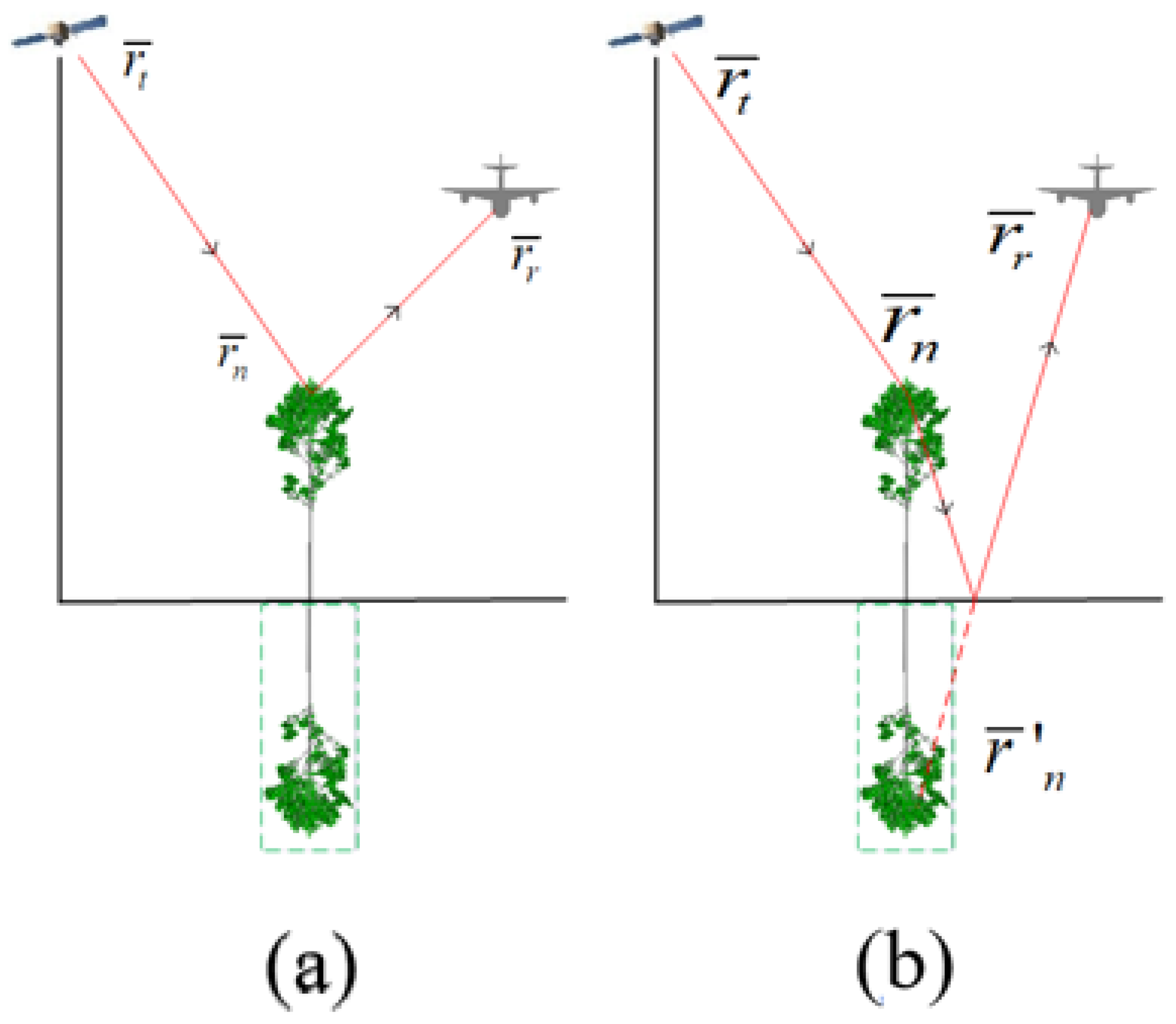
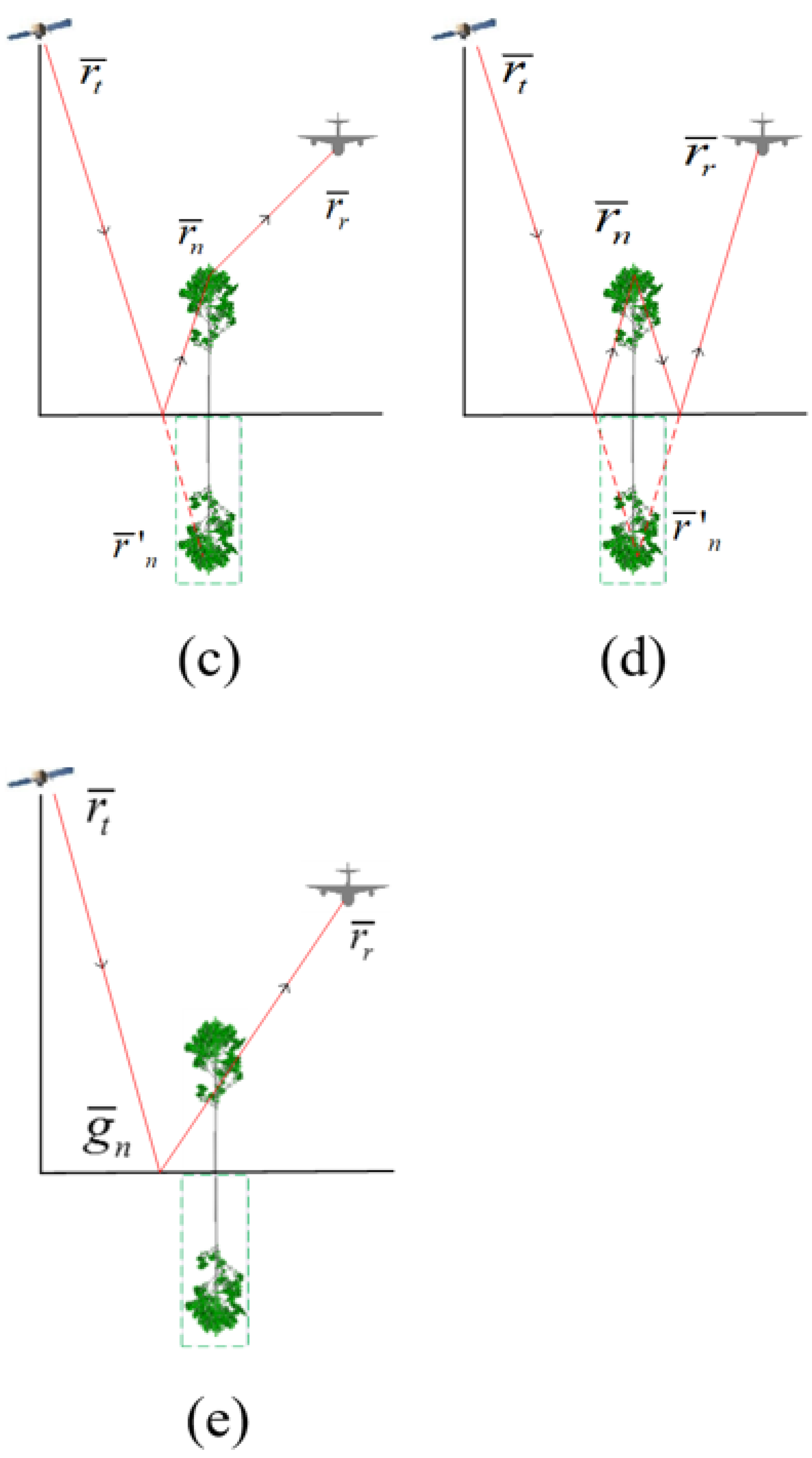

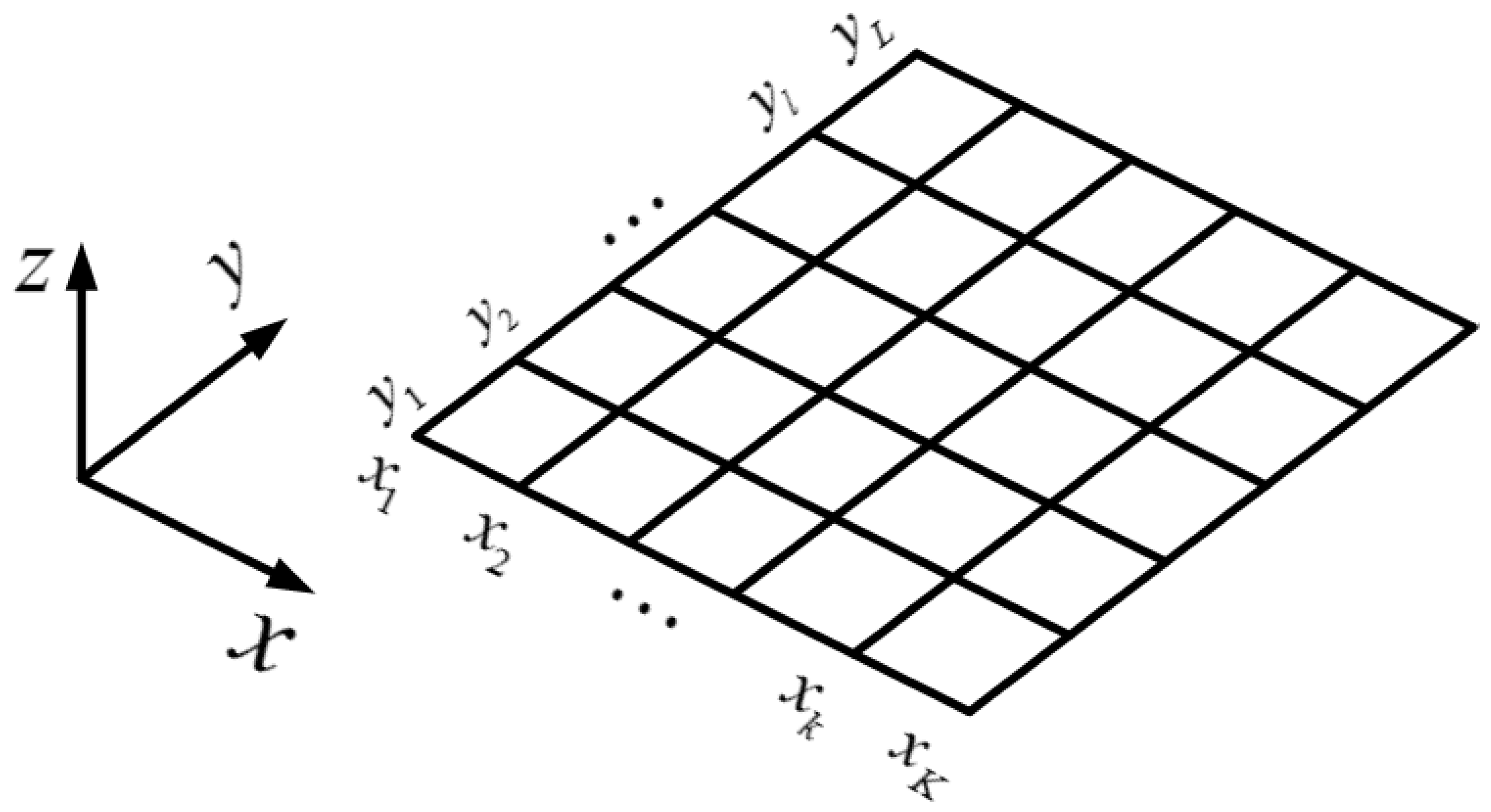
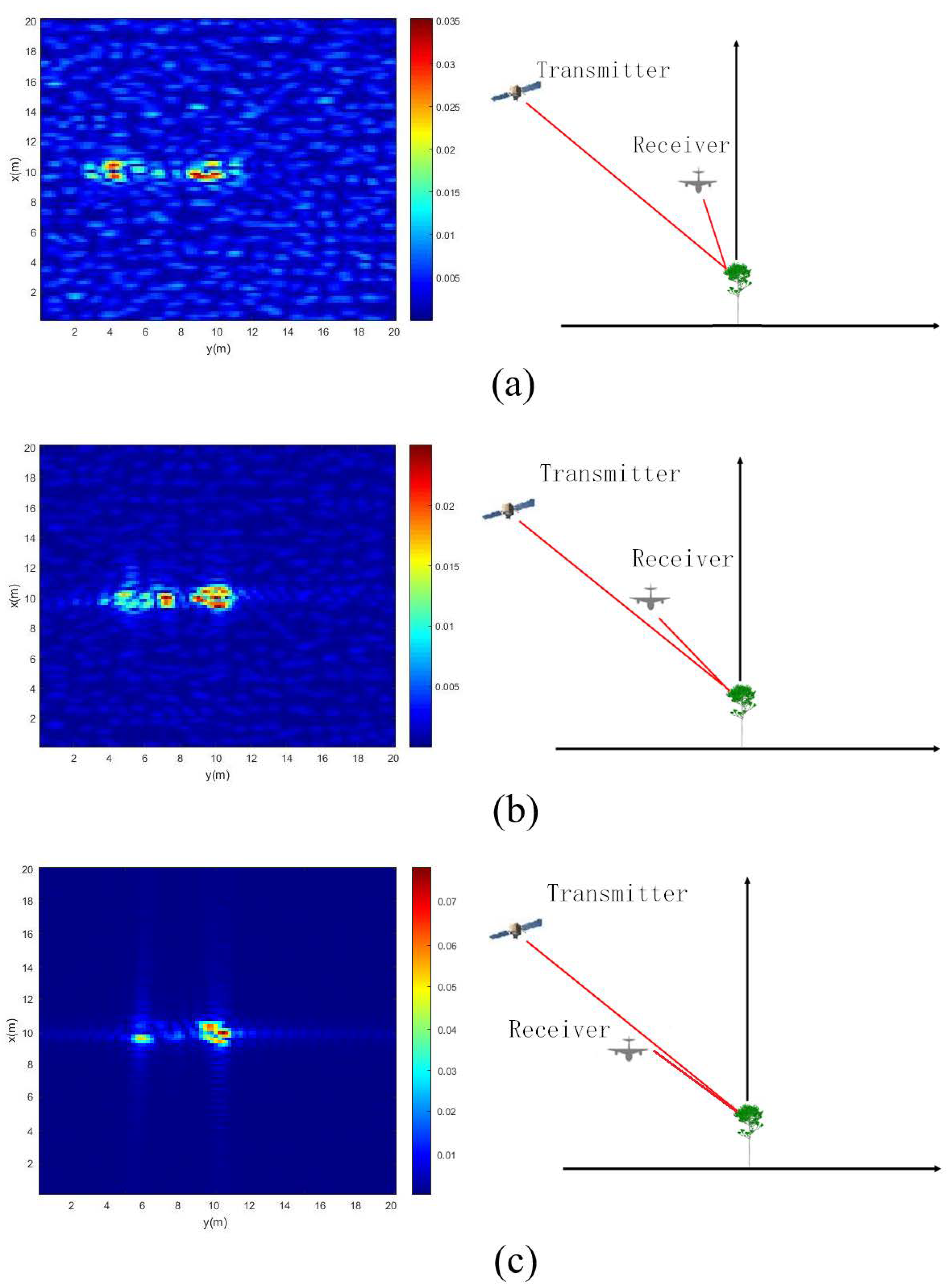



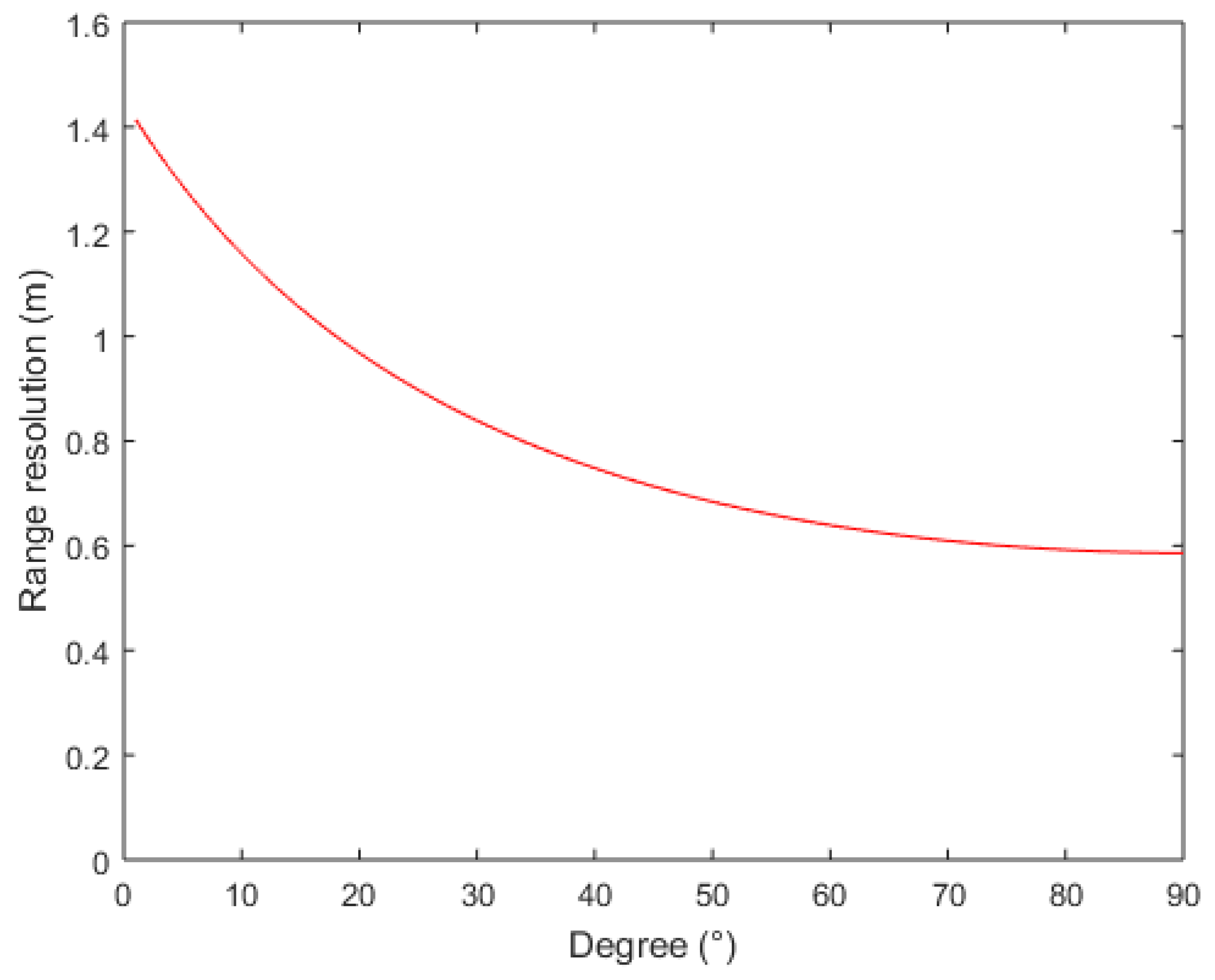
| Parameters | Value |
|---|---|
| Start frequency | 6 GHz |
| Frequency bandwidth | 300 MHz |
| Frequency sampling numbers | 50 |
| Flight height of the transmitter | 800 km |
| Flight height of the receiver | 8 km |
| Space sampling interval of transmitter | 500 m |
| Space sampling interval of receiver | 5 m |
| Space sampling numbers | 201 |
| Polarization | HH |
| Height of Trees | 4 m | 5 m | 6 m | |
|---|---|---|---|---|
| Leaf | Radius (m) | 0.04 | 0.04 | 0.04 |
| Thickness (mm) | 0.15 | 0.15 | 0.15 | |
| Density (N m−3) | 1360.0 | 580.0 | 250.0 | |
| Branch | Range of radius (cm) | 0.1–1.6 | 0.1–2.2 | 0.1–2.7 |
| Range of length (cm) | 1.0–103.8 | 1.0–178.8 | 1.0–195.0 | |
| Density (N m−3) | 180.0 | 60.0 | 45.0 | |
| Crown | Height (m) | 2.0 | 3.0 | 3.2 |
| Width (m) | 1.2 | 1.5 | 2.2 | |
| Parameters | Value |
|---|---|
| Leaves | 20.24 + i6.78 |
| Trunks | 12.30 + i4.16 |
| Branches | 12.30 + i4.16 |
| Ground | 9.6 + i2.04 |
| Zenith Angle of Receiver (°) | Value (m) |
|---|---|
| 26 | 0.87 |
| 36 | 0.77 |
| 46 | 0.70 |
| 56 | 0.65 |
| 66 | 0.62 |
| 76 | 0.60 |
Publisher’s Note: MDPI stays neutral with regard to jurisdictional claims in published maps and institutional affiliations. |
© 2022 by the authors. Licensee MDPI, Basel, Switzerland. This article is an open access article distributed under the terms and conditions of the Creative Commons Attribution (CC BY) license (https://creativecommons.org/licenses/by/4.0/).
Share and Cite
Chen, Z.; Qiao, X.; Wu, P.; Zhang, T.; Hong, T.; Fang, L. Unmanned Aerial Vehicle (UAV) Robot Microwave Imaging Based on Multi-Path Scattering Model. Sensors 2022, 22, 8736. https://doi.org/10.3390/s22228736
Chen Z, Qiao X, Wu P, Zhang T, Hong T, Fang L. Unmanned Aerial Vehicle (UAV) Robot Microwave Imaging Based on Multi-Path Scattering Model. Sensors. 2022; 22(22):8736. https://doi.org/10.3390/s22228736
Chicago/Turabian StyleChen, Zhihua, Xinya Qiao, Pei Wu, Tiancai Zhang, Tao Hong, and Linquan Fang. 2022. "Unmanned Aerial Vehicle (UAV) Robot Microwave Imaging Based on Multi-Path Scattering Model" Sensors 22, no. 22: 8736. https://doi.org/10.3390/s22228736
APA StyleChen, Z., Qiao, X., Wu, P., Zhang, T., Hong, T., & Fang, L. (2022). Unmanned Aerial Vehicle (UAV) Robot Microwave Imaging Based on Multi-Path Scattering Model. Sensors, 22(22), 8736. https://doi.org/10.3390/s22228736





